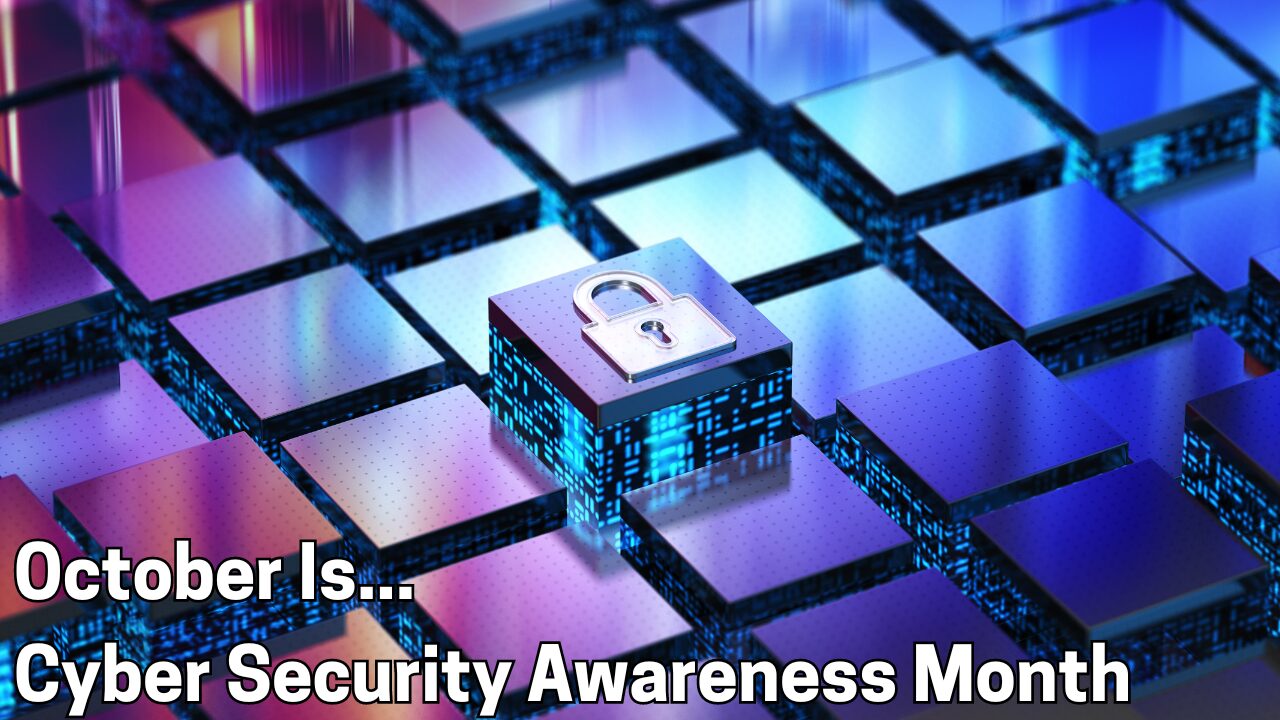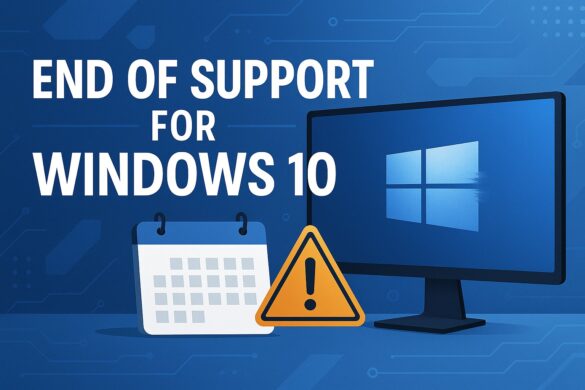October Is Cybersecurity Awareness Month – Why Every MSP Out There Will Remind You Of This: Protecting Your Digital Assets
October marks Cybersecurity Awareness Month, an annual event highlighting digital security’s critical importance. Managed Service Providers (MSPs) are crucial in promoting cybersecurity best practices and protecting clients from evolving threats. This month serves as a reminder for organizations to reassess their security measures and implement robust strategies to safeguard their digital assets.
MSPs are at the forefront of defense as cyber threats increase in sophistication and frequency. They offer expertise, tools, and support to help businesses strengthen their cybersecurity posture. During October, you can expect your MSP to emphasize the importance of cybersecurity awareness and provide guidance
The Importance of Cybersecurity Awareness Month
Cybersecurity Awareness Month highlights critical digital safety practices and empowers individuals and organizations to protect themselves online. It addresses current challenges, fosters a security-conscious culture, and keeps pace with evolving threats.
Understanding Cybersecurity Challenges
You face numerous cybersecurity risks in today’s interconnected world. Phishing attacks, malware, and data breaches threaten your personal and professional information.
Cybercriminals constantly develop new tactics to exploit vulnerabilities. To protect yourself effectively, you must stay informed about these threats.
Understanding common attack vectors helps you recognize and avoid potential dangers. Regular software updates, strong passwords, and multi-factor authentication are key defenses against many cyber threats.
Promoting a Culture of Security
Cybersecurity Awareness Month encourages you to adopt security-conscious behaviors year-round. It emphasizes the importance of taking daily actions to reduce online risks.
You play a crucial role in maintaining digital safety. By implementing best practices, you contribute to a more secure online environment for everyone.
Sharing knowledge with colleagues, friends, and family helps spread awareness. This collective effort strengthens overall cybersecurity posture across communities and organizations.
Evolving Threat Landscape
The cybersecurity landscape changes rapidly, with new threats emerging constantly. You must stay vigilant and adapt your security measures accordingly.
Ransomware attacks have become increasingly sophisticated and prevalent. Protecting your data through regular backups and robust security systems is essential.
The rise of Internet of Things (IoT) devices introduces new vulnerabilities. You should know the risks associated with connected devices in your home and workplace.
Artificial intelligence and machine learning are being used by both defenders and attackers. Understanding these technologies helps you prepare for future cyber challenges.
Role of Managed Service Providers (MSPs)
MSPs play a crucial role in safeguarding businesses against cyber threats. They offer expertise, tools, and continuous monitoring to protect their clients’ digital assets.
Key Responsibilities in Cybersecurity
MSPs are tasked with implementing robust security measures for their clients. They conduct regular risk assessments to identify vulnerabilities in your systems.
MSPs also set up firewalls, anti-malware software, and intrusion detection systems to protect your network. They manage software updates and patches to address security flaws promptly.
Another vital responsibility is employee training. MSPs educate your staff on cybersecurity best practices, helping them recognize phishing attempts and other social engineering tactics.
MSPs provide key services such as 24/7 monitoring. They monitor for suspicious activities and respond swiftly to potential threats, minimizing damage from cyberattacks.
Benefits of MSP Involvement in Cybersecurity
Partnering with an MSP brings numerous advantages to your cybersecurity efforts. You gain access to specialized expertise that may be costly or difficult to maintain in-house.
MSPs offer cost-effective solutions by spreading the expense of advanced security tools across multiple clients. This allows you to benefit from enterprise-grade protection at a fraction of the cost.
You also receive proactive threat management. MSPs stay updated on the latest cybersecurity trends and emerging threats, ensuring your defenses remain current.
Compliance management is another valuable benefit. MSPs help you navigate complex regulatory requirements, ensuring your cybersecurity measures meet industry standards.
Strategies and Tips for Enhancing Cybersecurity
Implementing robust cybersecurity measures is crucial for protecting your digital assets and sensitive information. The following strategies and tools can significantly bolster your organization’s security posture.
Effective Security Practices
Strong passwords and multi-factor authentication are fundamental to enhancing cybersecurity. Create unique, complex passwords for each account and enable MFA wherever possible.
Update and patch your software and systems regularly to address vulnerabilities. Set up automatic updates to ensure you’re always running the latest versions.
Implement a robust backup strategy. Store backups offsite or in the cloud and test them regularly to ensure quick recovery in case of a breach or ransomware attack.
Encrypt sensitive data both at rest and in transit. This adds an extra layer of protection, making it harder for unauthorized parties to access your information.
Employee Training and Awareness Programs
Educate your staff on recognizing and reporting phishing attempts. Conduct regular simulations to test and reinforce their ability to spot suspicious emails.
Develop a comprehensive security policy. Clearly outline acceptable use of company resources, data handling procedures, and incident response protocols.
Foster a culture of security awareness. Encourage employees to report potential security issues without fear of reprisal. Reward those who demonstrate good security practices.
Provide ongoing training on emerging threats and best practices. Cybersecurity is an ever-evolving field, so keep your team updated with the latest knowledge and skills.
Technological Tools and Solutions
Deploy a next-generation firewall to monitor and control network traffic. This helps prevent unauthorized access and protects against various cyber threats.
Implement endpoint detection and response (EDR) solutions. These tools can quickly identify and respond to threats on individual devices across your network.
Use virtual private networks (VPNs) for secure remote access. This is especially important with the rise of remote work, as it ensures encrypted connections for off-site employees.
Consider adopting a zero-trust security model. This approach verifies every user and device attempting to access your network, regardless of location.
Employ security information and event management (SIEM) systems. These tools aggregate and analyze log data from various sources, helping you detect and respond to security incidents more effectively.

Implementing a Cybersecurity Framework
A robust cybersecurity framework provides structure and guidance for protecting your organization’s digital assets. It helps you identify risks, implement controls, and respond to incidents effectively.
Foundation of Cybersecurity Measures
Start by conducting a thorough risk assessment to identify vulnerabilities in your systems. Prioritize these risks based on their potential impact and likelihood of occurrence.
Develop clear security policies and procedures tailored to your organization’s needs. These should cover areas like access control, data protection, and incident response.
Implement strong authentication measures, such as multi-factor authentication, to protect user accounts. Encrypt sensitive data both at rest and in transit.
Train your employees regularly on cybersecurity best practices. They are often the first line of defense against threats like phishing attacks.
Continuous Monitoring and Improvement
Set up a system for continuous monitoring of your network and systems. This allows you to detect and respond to potential threats quickly.
Use security information and event management (SIEM) tools to aggregate and analyze log data from various sources. This helps identify patterns and anomalies that may indicate a security breach.
Conduct regular vulnerability scans and penetration tests to identify weaknesses in your defenses. Address any issues found promptly.
Stay informed about the latest cybersecurity threats and trends. Update your security measures regularly to address new risks.
Review and update your cybersecurity framework periodically. As your organization evolves, so should your security measures.
Cybersecurity Awareness Initiatives and Events
Cybersecurity awareness initiatives and events are crucial in educating and engaging organizations and individuals. These efforts focus on providing practical knowledge and fostering collaboration to enhance cyber resilience.
Organizing Workshops and Seminars
During Cybersecurity Awareness Month, you can expect a variety of workshops and seminars. These events often cover password security, phishing prevention, and data protection.
Many organizations host interactive sessions where you can learn about the latest threats and defense strategies. Some workshops may include hands-on exercises to help you practice identifying and responding to cyber attacks.
Virtual webinars have become increasingly popular, allowing you to participate from anywhere. These online events often feature expert speakers and Q&A sessions, giving you direct access to cybersecurity professionals.
Collaboration and Public-Private Partnerships
Public-private partnerships form the backbone of many Cybersecurity Awareness Month initiatives. Government agencies like CISA work closely with private sector companies to develop and distribute educational materials.
You might see joint cybersecurity campaigns that leverage resources from both sectors. These collaborations often result in free toolkits, guides, and online resources that you can use to improve your cybersecurity practices.
Some partnerships focus on specific industries, addressing sector-specific threats and regulations. This targeted approach helps you understand the unique challenges your organization may face.
Conclusion
Cybersecurity Awareness Month serves as a crucial reminder for MSPs and their clients. Your vigilance in protecting digital assets is paramount year-round.
Take this opportunity to reassess your security measures. Implement stronger passwords, enable multi-factor authentication, and keep software up-to-date.
Educate yourself and your team on the latest cybersecurity threats. Stay informed about emerging technologies and their potential risks.
Remember, cybersecurity is a shared responsibility. Work closely with your MSP to develop a comprehensive security strategy tailored to your needs.
Consider these key actions:
- Conduct regular security audits
- Implement robust backup solutions
- Train employees on best practices
- Stay informed about industry regulations
By prioritizing cybersecurity, you protect your business and your clients’ trust. Make every month a cybersecurity awareness month in your organization.
Commit to being more cyber-secure today. Your proactive approach will help safeguard your digital future.
Contents
- 1 October Is Cybersecurity Awareness Month – Why Every MSP Out There Will Remind You Of This: Protecting Your Digital Assets
- 2 The Importance of Cybersecurity Awareness Month
- 3 Role of Managed Service Providers (MSPs)
- 4 Strategies and Tips for Enhancing Cybersecurity
- 5 Implementing a Cybersecurity Framework
- 6 Cybersecurity Awareness Initiatives and Events
- 7 Conclusion



